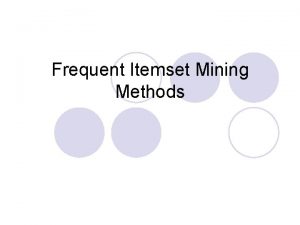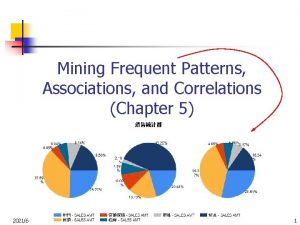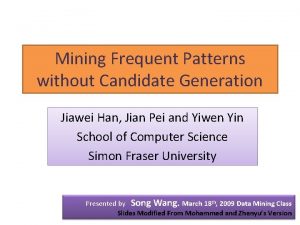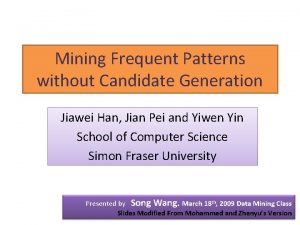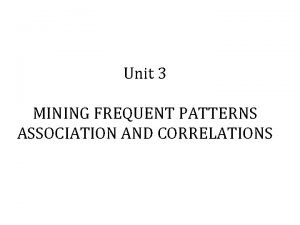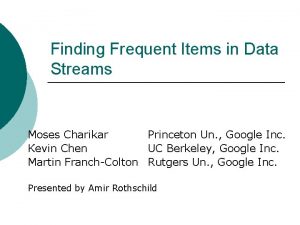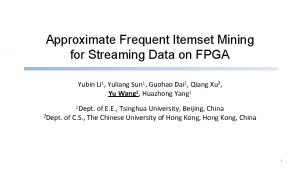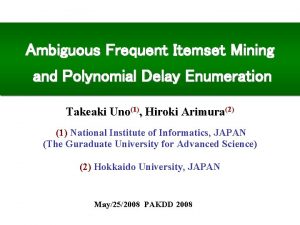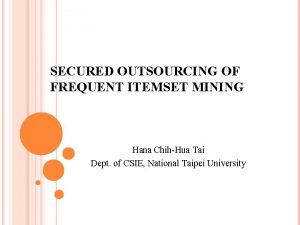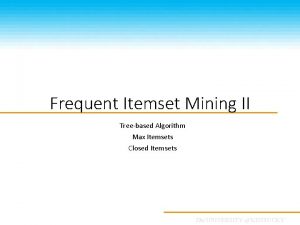Approximate Frequent Itemset Mining for Streaming Data on


![Related Work ØMulti-scan approaches (Exact Method) ØAlgorithms: Aprior[1], FP-growth[2], Eclat[3] ØRequire to scan original Related Work ØMulti-scan approaches (Exact Method) ØAlgorithms: Aprior[1], FP-growth[2], Eclat[3] ØRequire to scan original](https://slidetodoc.com/presentation_image_h/140cbc5d55b9b873bead93e7f25a4508/image-3.jpg)








- Slides: 11

Approximate Frequent Itemset Mining for Streaming Data on FPGA Yubin Li 1, Yuliang Sun 1, Guohao Dai 1, Qiang Xu 2, Yu Wang 1, Huazhong Yang 1 1 Dept. of E. E. , Tsinghua University, Beijing, China 2 Dept. of C. S. , The Chinese University of Hong Kong, China 1

Introduction to FIM ØFIM: Frequent Itemset Mining is designed to find frequently occurring itemsets among a series of transactions. It is a fundamental problem of mining association rules. ØFIM-DS: Frequent Itemset Mining from a Data Stream (real time) ØChallenges: ØExponential candidate space an L-length transaction generates 2 L subsets ØComplexity in data itself itemsets have different number of items (input with different width) ØReal-time requirements storing the infinite data into memory is infeasible 2
![Related Work ØMultiscan approaches Exact Method ØAlgorithms Aprior1 FPgrowth2 Eclat3 ØRequire to scan original Related Work ØMulti-scan approaches (Exact Method) ØAlgorithms: Aprior[1], FP-growth[2], Eclat[3] ØRequire to scan original](https://slidetodoc.com/presentation_image_h/140cbc5d55b9b873bead93e7f25a4508/image-3.jpg)
Related Work ØMulti-scan approaches (Exact Method) ØAlgorithms: Aprior[1], FP-growth[2], Eclat[3] ØRequire to scan original data more than one time (real-time violation) ØApproximate approaches ØSample algorithms: take parts of the new candidates into consideration when the candidate table is full (Sticky Sampling[4], Chernoff-based algorithm[5]) ØDelete algorithms: count all candidates but delete lower-support candidates from current memory (Lossy Counting[4], Stream. Mining algorithm[6]) Exponential candidates are generated from each received transaction. Then they treat each candidate as an element and compare it with candidates in the candidate table. [1] R. Agrawal, et al. , “Fast algorithms for mining association rules, ” VLDB 1994. [2] J. Han, et al, “Frequent pattern mining: current status and future directions, ” 2007 [3] Y. Zhang et al, An fpga-based accelerator frequent item-set mining, TRETS 2013. [4] G. S. Manku et al, Approximate frequency counts over data streams, VLDB 2002. [5] R. C. -W. et al, Mining top-k frequent itemsets from data streams, 2006. [6] R. Jin et al, An algorithm for in-core frequent itemset mining on streaming data, 2005 3

Motivation Candidate table {A, B}: 12 {A, C}: 11 {A, C}: 10 {B, D}: 9 {A, D} {A, C} {A, D} Assume a new input {A, C, D, E} {A, B, D}: 9 {A, D}: 10 {A, D}: 9 {A, E}: 7 {B, E}: 4 {A, B, E}: 3 {A, D} Subsets: {A, C} {A, D} {A, E} {C, D} {C, E} {D, E} {A, C, D} {A, C, E} {C, D, E} {A, C, D, E} Weaks: 1. Exponential subsets generation and comparisons 2. The width of input is variable because of the different number of items 3. Itemset comparisons may need to compare one item each cycle and consumes different cycles for different input We try to: 1. Regard one input as one unit and avoid exponential subsets generation 2. Adopt special data representation to fix the data width and decrease the bandwidth requirement 3. Use simple operation to replace multiple item comparisons 4. Accelerate it with high parallelism of FPGA 4

Our Work ØPropose the Space-Saving based FIM-DS algorithm ØEHBR data representation: adopt the Equivalent Horizontal Bitvector Representation to represent every transaction (itemset). ―Transaction independent (real time), while EVBR (Eclat algorithm) depend on all the input transaction ―Avoids exponential candidates generation ØTake “Bitwise-AND” operation between bitvectors to find their complex set relationships ØAvoids exponential candidates comparisons Bitwise-AND operation: (a) Example input transactions (b) Corresponding vertical representation - bitvector a represent one input transaction - bitvector b represent one frequent candidate è if (a & b == b) b is subset of a, and increase its support (c) EVBR data representation (d) EHBR data representation 5

Our Work ØSpace-Saving based FIM-DS algorithm ØInitialization Phase • Initialize the candidate table with interested itemsets or subsets of the first few input transactions. ØFrequency Counting Phase (support update) • Take “bitwise-and” operation between input and candidates in table, and update their supports. ØReplacement Phase (candidate update) • Replace small support candidates in table with some subsets frequently occurring in recent period Frequency counting phase and replacement phase runs alternately. The number of operations in either phase can be adjusted. 6

Our Work ØHardware Accelerator ØTranslators : translate input transactions to bitvectors, and vice versa. ØCounter: count the number of input transactions processed in one frequent counting phase. When it reaches the user-defined threshold, the system steps into replacement phase. ØPEs-pipeline accelerator: PEs are arranged in a ring-pipeline. It implements the frequency counting phase and replacement phase alternately. ØEncoder/Decoder: compress the bitvector (binary sequece) to decrease the bandwidth requirement (applied when item database is very large). hardware system overview PEs pipeline accelerator processing element (PE) 7

Evaluation ØExperimental Setup Ø Software: • Intel(R) Core(TM) i 7 -4790 CPU (@3. 60 GHz) Ø Hardware: • VC 707 board with an Virtex 7 485 t chip working at 150 MHz Ø Datasets: Dataset Num. Items Num. Trans. Average Length Size (MB) chess 75 3196 37 0. 342 connect 129 67557 43 9. 300 T 40 I 10 D 0 3 N 500 K 299 500 k 40 214. 000 T 10. I 4. 1000 K 10 k 1000 k 10 121. 000 8

Evaluation ØResource Utilization Acc. 128 Resource Available LUTs REGs ØPerformance Acc. 256 Acc. 512 Used Utilization 303600 60903 20. 06% 121957 40. 17% 270508 89. 10% 607200 48698 8. 02% 104500 17. 21% 231647 38. 15% Dataset Time(s) [work] chess. dat Our SW. 512 Our SW. 1024 x 10 Our FPGA. 512 Time(s) Speedup >3. 3[1] 0. 072 45. 8 0. 375 8. 8 4. 398 0. 75 1. 9 x 10 -4 1. 7 x 104 connect. dat >121. 5[1] 1. 152 105. 5 1. 863 65. 2 14. 482 8. 4 2. 4 x 10 -3 5. 0 x 104 T 40 I 10 D 0 3 N 500 K 12. 05[2] 8. 592 1. 4 17. 048 0. 7 - - 0. 21 57 T 10. I 4. 1000 K 17. 0[3] 209. 920 0. 1 405. 409 - - - 0. 75 22. 6 T 10. I 4. 1000 K 4. 0[4] 209. 920 - 405. 409 - - - 0. 75 5. 3 • Our proposed algorithm is efficient when item database is small, and its performance decreases as the item database grows; • Our hardware accelerator achieves better performance on both small item database datasets and large item database datasets. [1] S. Sun, et al, Design and analysis of a reconfigurable platform for frequent pattern mining, Parallel and Distributed Systems 2011 [2] Y. Zhang et al, An fpga-based accelerator frequent item-set mining, TRETS 2013. [3] G. S. Manku et al, Approximate frequency counts over data streams, VLDB 2002. [4] R. Jin et al, An algorithm for in-core frequent itemset mining on streaming data, 2005 9

To Do… ØFurther Investigate the relationship between accuracy rate and different parameters in the proposed algorithm: • • threshold_trans : the number of transactions to process in one frequency counting phase; threshold_item : item whose support is not less than the threshold can be one element of the input subset in replacement phase; threshold_replacement : the maximal number of replacement can occurs in one replacement phase; … 10

Thanks for your listening! 11
 Frequent itemset mining methods
Frequent itemset mining methods Eck
Eck Associations and correlations in data mining
Associations and correlations in data mining X videos
X videos Dbminer
Dbminer Mining frequent patterns without candidate generation
Mining frequent patterns without candidate generation Mining frequent patterns associations and correlations
Mining frequent patterns associations and correlations Mining multimedia databases
Mining multimedia databases Finding frequent items in data streams
Finding frequent items in data streams Strip mining vs open pit mining
Strip mining vs open pit mining Mineral resources and mining chapter 13
Mineral resources and mining chapter 13 Difference between strip mining and open pit mining
Difference between strip mining and open pit mining
